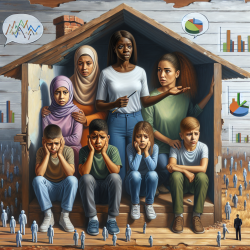Introduction
Unstable housing among high school students is a critical issue that impacts their health and well-being. The Experiences of Unstable Housing Among High School Students — Youth Risk Behavior Survey, United States, 2021 provides valuable insights into the prevalence and impact of housing instability on youth. As practitioners in speech-language pathology, understanding these dynamics can enhance our ability to support at-risk students effectively.
Key Findings from the Research
The 2021 Youth Risk Behavior Survey revealed that 2.7% of U.S. high school students experienced unstable housing. This population is disproportionately composed of racial minorities, particularly Native Hawaiian or other Pacific Islander, American Indian or Alaska Native, and Black youths. Sexual minority youths also face a higher prevalence of unstable housing compared to their heterosexual peers.
Youths experiencing unstable housing are more likely to engage in risky behaviors, such as substance use and risky sexual activities, and are at increased risk for mental health issues, including suicide ideation and attempts. These findings underscore the need for targeted interventions to address these elevated risks.
Implications for Practitioners
As practitioners, it is crucial to integrate these findings into our practice to better support students facing housing instability. Here are some actionable steps:
- Enhance Awareness: Educate yourself and your colleagues about the signs of housing instability and its impact on students' health and behavior.
- Collaborate with Schools: Work closely with school counselors and social workers to identify at-risk students and provide them with the necessary support.
- Advocate for Resources: Advocate for school-based programs that address the needs of unstably housed students, such as mental health services and safe spaces for sexual minority youths.
- Implement Data-Driven Interventions: Use data from the YRBS and other sources to inform evidence-based interventions tailored to the specific needs of unstably housed students.
Encouraging Further Research
While the YRBS provides a comprehensive overview of housing instability among high school students, further research is needed to explore the underlying causes and effective interventions. Practitioners can contribute to this body of knowledge by:
- Conducting Local Studies: Engage in research within your community to identify specific challenges and resources related to housing instability.
- Sharing Best Practices: Collaborate with other professionals to share successful strategies and interventions for supporting unstably housed students.
- Participating in Policy Advocacy: Advocate for policies that address the root causes of housing instability and support vulnerable populations.
Conclusion
Understanding the experiences of unstably housed students is essential for practitioners aiming to improve outcomes for at-risk youth. By integrating data-driven insights into our practice and advocating for comprehensive support systems, we can make a significant impact on the lives of these students.
To read the original research paper, please follow this link: Experiences of Unstable Housing Among High School Students — Youth Risk Behavior Survey, United States, 2021.










